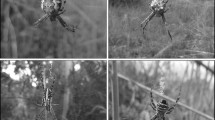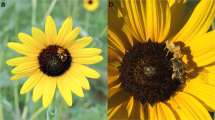Abstract
Although rewarded bees learn and remember colors and patterns, they have difficulty in learning to avoid negative stimuli such as decorated spider webs spun by Argiope argentata. A. argentata decorates its web with silk patterns that vary unpredictably (Fig. 1) and thus foraging insects that return to sites where spiders are found encounter new visual cues daily. Stingless bees can learn to avoid spider webs but avoidance-learning is slowed or inhibited by daily variation in web decorations (Figs. 3,4; Tables 1,2). In addition, even if bees learn to avoid decorated webs found in one location, they are unable to generalize learned-avoidance responses to similarly decorated webs found at other sites. A. argentata seems to have evolved a foraging behavior that is tied to the ways insects perceive and process information about their environment. Because of the evolutionary importance of bee-flower interdependence, the predatory behavior of web-decorating spiders may be difficult for natural selection to act against.
Similar content being viewed by others
References
Anderson AM (1977a) The influence of pointed regions on the shape preference on honey bees. Anim Behav 25:88–94
Anderson AM (1977b) Parameters determining the attractiveness of stripe patterns in the honey bee. Anim Behav 25:80–87
Anderson AM (1977c) Shape perception in the honey bee. Anim Behav 25:62–79
Chittka L, Menzel R (1992) The evolutionary adaptation of flower colours and the insect pollinators' color vision. J Comp Physiol A 171:171–181
Coddington J (1986) The monophyletic origin of the orb-web. In: Shear WA (ed) Spiders: webs, behavior and evolution. Stanford University Press, Stanford, pp 319–363
Craig CL (1989) Alternative foraging modes of orb web weaving spiders. Biotropica 21:257–363
Craig CL (1991) Physical constraints on group foraging and social evolution: observations on web-spinning spiders. Funct Ecol 5:649–654
Craig CL (1992) Aerial web-weaving spiders: linking molecular and organismal processes in evolution. Trends Ecol Evol 7:270–273
Craig CL (1994) Limits to learning: effects of predator pattern and color on perception and avoidance-learning by prey. Anim Behav (in press)
Craig CL, Bernard GD (1990) Insect attraction to ultraviolet-reflecting spiders and web decorations. Ecology 71:616–623
Craig CL, Ebert K (1994) Color and pattern in predator-prey interactions: the bright body colors and patterns of tropical orb-spinning spiders attract flower-seeking prey. Funct Ecol (in press)
Eberhard WG (1973) Stabilimenta on the webs of Uloborus diversus (Araneae:Uloboridae) and other spiders. J Linn Soc 171:367–384
Edmunds J (1986). The stabilimenta of Argiope flavipalpis and Argiope trifasciata in West Africa, with a discussion of the function of stabilimenta. In: Eberhard WG, Lubin YD, Robinson, B.C. (ed) Proceedings of the Ninth International Congress of Arachnology. Smithsonian Institution Press, Washington DC, pp 61–72
Eisner T, Nowicki S (1983) Spider web protection through visual advertisement: role of the stabilimentum. Science 219:185–186
Frisch K von (1914) Der Farbensinn und Formensinn der Biene. Zool J Physiol 37:1–238
Gould J (1985) How bees remember flower shapes. Science 227:1492–1494
Hingston RWG (1927) Protective devices in spiders' snares, with a description of seven new species of orb-weaving spiders. Proc Zool Soc 18:259–293
Howell FC, Ellender RD (1984) Observations on growth and diet of Argiope aurantia Lucas (Araneidae) in a successional habitat. J Arachnol 12:29–36
Humphreys WF (1992) Stabilimenta as parasols: shade construction by Neogea sp. (Araneae: Araneidae, Argiopinae) and its thermal behaviour. Bull Br Arachnol Soc 9:47–52
Lubin YD (1975) Stabilimenta and barrier webs in the orb webs of Argiope argentata (Araneae, Araneidae) on Daphne and Santa Cruz Islands, Galapagos. J Arachnol 2:119–126
McReynolds CN, Polis GA (1987) Ecomorphological factors influencing prey use by two sympatric species of orb-web spiders, Argiope aurantia and Argiope trifasciata (Araneidae). J Arachnol 15:371–384
Menzel R (1967) Das Erlernen von Spektralfarben durch die Honigbiene (Apis mellifera). Z Vergl Physiol 56:22–62
Menzel R (1984) Memory traces in honeybees. In: Menzel R, Mercer A (eds) Neurobiology and behaviour of honeybees. Springer, New York, pp 310–325
Menzel R (1985) Learning in honey bees in an ecological and behavioural context. In: Holldobler B, Lindauer M (eds) Experimental behavioural ecology (Fortschritte der Zoologie 31) Gustav Fischer Verlag, NY pp 55–74
Nentwig W, Rogg H (1988) The cross stabilimentum of Argiope argentata — nonfunctional or a nonspecific stress reaction? Zool Anz 221:248–266
Robinson MH, Robinson B (1970a) Prey caught by a sample population of the spider Argiope argentata (Araneae. Araneidae) in Panama, a year's census data. J Linn Soc 49:345–357
Robinson MH, Robinson B (1970b) The stabilimentum of the orb web spider, Argiope argentata: an improbable defense against predators. Can Entomol 102:641–655
Rypstra A (1982) Building a better insect trap; an experimental investigation of prey capture in a variety of spider webs. Oecologia 52:31–36
Smith RB, Mommsen TP (1984) Pollen feeding in an orb-weaving spider. Science 226:1330–1332
Snedecor GW, Cochran WC (1980) Statistical methods. Iowa State University, Ames
Wehner R (1968) Die Bedeutung der Streifenbreite fur die optische Winkelmessung der Biene (Apis mellifera). Z Vergl Physiol 58:322–342
Wehner R (1971) The generalization of direction stimuli in the honey bee, Apis mellifera. J Insect Physiol 17:1579–1591
Wehner R, Lindauer M (1966) Zur Physiologie des Formensehens bei der Honigbiene. I. Winkelunterscheidung an vertikal orientierten Streifenmustern. Z Vergl Physiol 52:290–324
Author information
Authors and Affiliations
Rights and permissions
About this article
Cite this article
Craig, C.L. Predator foraging behavior in response to perception and learning by its prey: interactions between orb-spinning spiders and stingless bees. Behav Ecol Sociobiol 35, 45–52 (1994). https://doi.org/10.1007/BF00167059
Received:
Accepted:
Issue Date:
DOI: https://doi.org/10.1007/BF00167059




